Business Transactions & Accounting: Kool Kit Ltd Report, UWL
VerifiedAdded on 2023/04/06
|8
|1962
|98
Report
AI Summary
This report provides advice to Mr. Till, director of Kool Kit Ltd, a kilt manufacturing business, regarding accounting procedures. It covers the importance of accounting information, the differences between gross and net profit with numerical examples, and the distinction between current and non-current assets and liabilities. The report also explains the double-entry bookkeeping system, its origins with Luca Pacioli, and the concepts of debit and credit. The analysis uses examples such as Apple's financial data to illustrate key concepts. The report concludes that maintaining accurate books of accounts using the double-entry system is crucial for analyzing records and finalizing accounts.
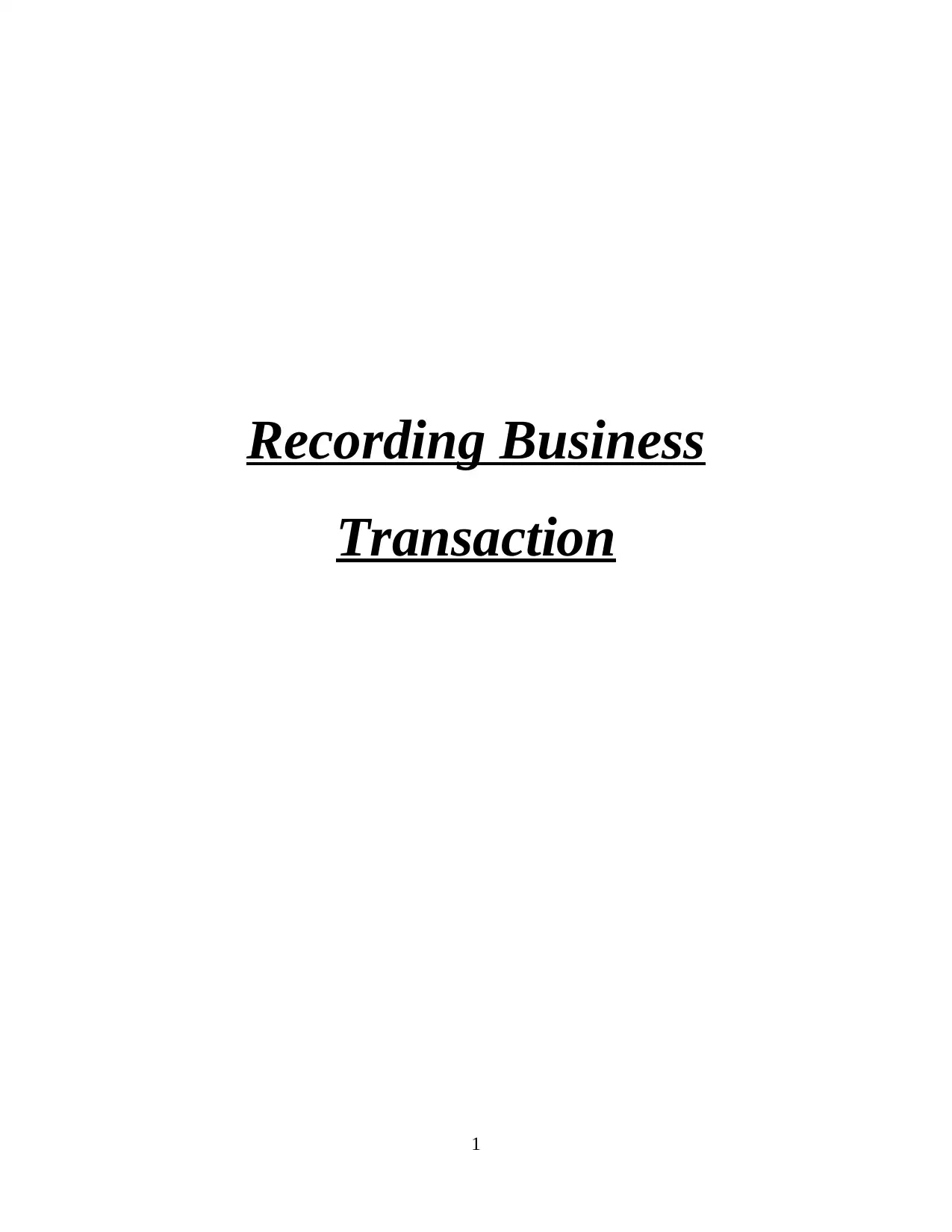
Recording Business
Transaction
1
Transaction
1
Paraphrase This Document
Need a fresh take? Get an instant paraphrase of this document with our AI Paraphraser
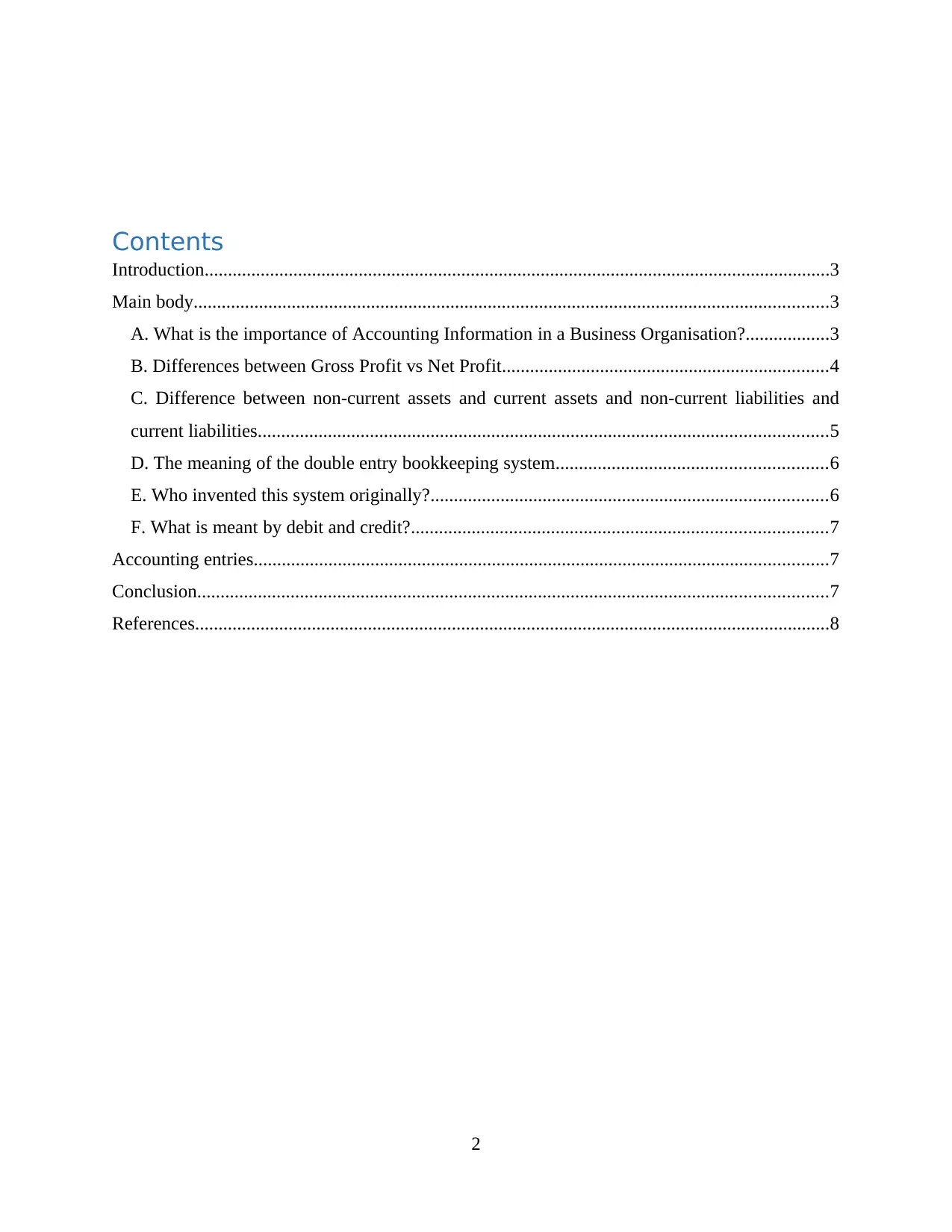
Contents
Introduction......................................................................................................................................3
Main body........................................................................................................................................3
A. What is the importance of Accounting Information in a Business Organisation?..................3
B. Differences between Gross Profit vs Net Profit......................................................................4
C. Difference between non-current assets and current assets and non-current liabilities and
current liabilities..........................................................................................................................5
D. The meaning of the double entry bookkeeping system..........................................................6
E. Who invented this system originally?.....................................................................................6
F. What is meant by debit and credit?.........................................................................................7
Accounting entries...........................................................................................................................7
Conclusion.......................................................................................................................................7
References........................................................................................................................................8
2
Introduction......................................................................................................................................3
Main body........................................................................................................................................3
A. What is the importance of Accounting Information in a Business Organisation?..................3
B. Differences between Gross Profit vs Net Profit......................................................................4
C. Difference between non-current assets and current assets and non-current liabilities and
current liabilities..........................................................................................................................5
D. The meaning of the double entry bookkeeping system..........................................................6
E. Who invented this system originally?.....................................................................................6
F. What is meant by debit and credit?.........................................................................................7
Accounting entries...........................................................................................................................7
Conclusion.......................................................................................................................................7
References........................................................................................................................................8
2
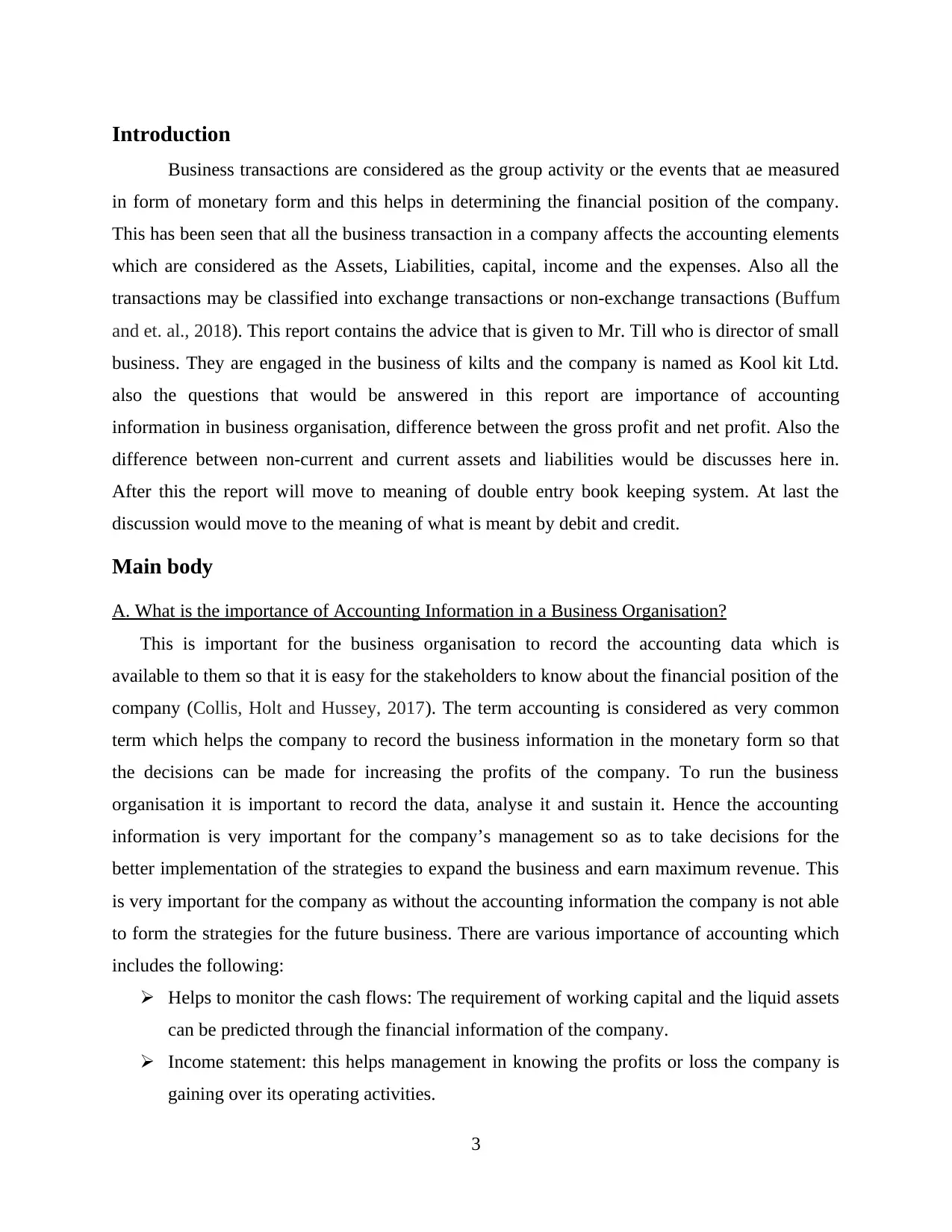
Introduction
Business transactions are considered as the group activity or the events that ae measured
in form of monetary form and this helps in determining the financial position of the company.
This has been seen that all the business transaction in a company affects the accounting elements
which are considered as the Assets, Liabilities, capital, income and the expenses. Also all the
transactions may be classified into exchange transactions or non-exchange transactions (Buffum
and et. al., 2018). This report contains the advice that is given to Mr. Till who is director of small
business. They are engaged in the business of kilts and the company is named as Kool kit Ltd.
also the questions that would be answered in this report are importance of accounting
information in business organisation, difference between the gross profit and net profit. Also the
difference between non-current and current assets and liabilities would be discusses here in.
After this the report will move to meaning of double entry book keeping system. At last the
discussion would move to the meaning of what is meant by debit and credit.
Main body
A. What is the importance of Accounting Information in a Business Organisation?
This is important for the business organisation to record the accounting data which is
available to them so that it is easy for the stakeholders to know about the financial position of the
company (Collis, Holt and Hussey, 2017). The term accounting is considered as very common
term which helps the company to record the business information in the monetary form so that
the decisions can be made for increasing the profits of the company. To run the business
organisation it is important to record the data, analyse it and sustain it. Hence the accounting
information is very important for the company’s management so as to take decisions for the
better implementation of the strategies to expand the business and earn maximum revenue. This
is very important for the company as without the accounting information the company is not able
to form the strategies for the future business. There are various importance of accounting which
includes the following:
Helps to monitor the cash flows: The requirement of working capital and the liquid assets
can be predicted through the financial information of the company.
Income statement: this helps management in knowing the profits or loss the company is
gaining over its operating activities.
3
Business transactions are considered as the group activity or the events that ae measured
in form of monetary form and this helps in determining the financial position of the company.
This has been seen that all the business transaction in a company affects the accounting elements
which are considered as the Assets, Liabilities, capital, income and the expenses. Also all the
transactions may be classified into exchange transactions or non-exchange transactions (Buffum
and et. al., 2018). This report contains the advice that is given to Mr. Till who is director of small
business. They are engaged in the business of kilts and the company is named as Kool kit Ltd.
also the questions that would be answered in this report are importance of accounting
information in business organisation, difference between the gross profit and net profit. Also the
difference between non-current and current assets and liabilities would be discusses here in.
After this the report will move to meaning of double entry book keeping system. At last the
discussion would move to the meaning of what is meant by debit and credit.
Main body
A. What is the importance of Accounting Information in a Business Organisation?
This is important for the business organisation to record the accounting data which is
available to them so that it is easy for the stakeholders to know about the financial position of the
company (Collis, Holt and Hussey, 2017). The term accounting is considered as very common
term which helps the company to record the business information in the monetary form so that
the decisions can be made for increasing the profits of the company. To run the business
organisation it is important to record the data, analyse it and sustain it. Hence the accounting
information is very important for the company’s management so as to take decisions for the
better implementation of the strategies to expand the business and earn maximum revenue. This
is very important for the company as without the accounting information the company is not able
to form the strategies for the future business. There are various importance of accounting which
includes the following:
Helps to monitor the cash flows: The requirement of working capital and the liquid assets
can be predicted through the financial information of the company.
Income statement: this helps management in knowing the profits or loss the company is
gaining over its operating activities.
3
⊘ This is a preview!⊘
Do you want full access?
Subscribe today to unlock all pages.

Trusted by 1+ million students worldwide
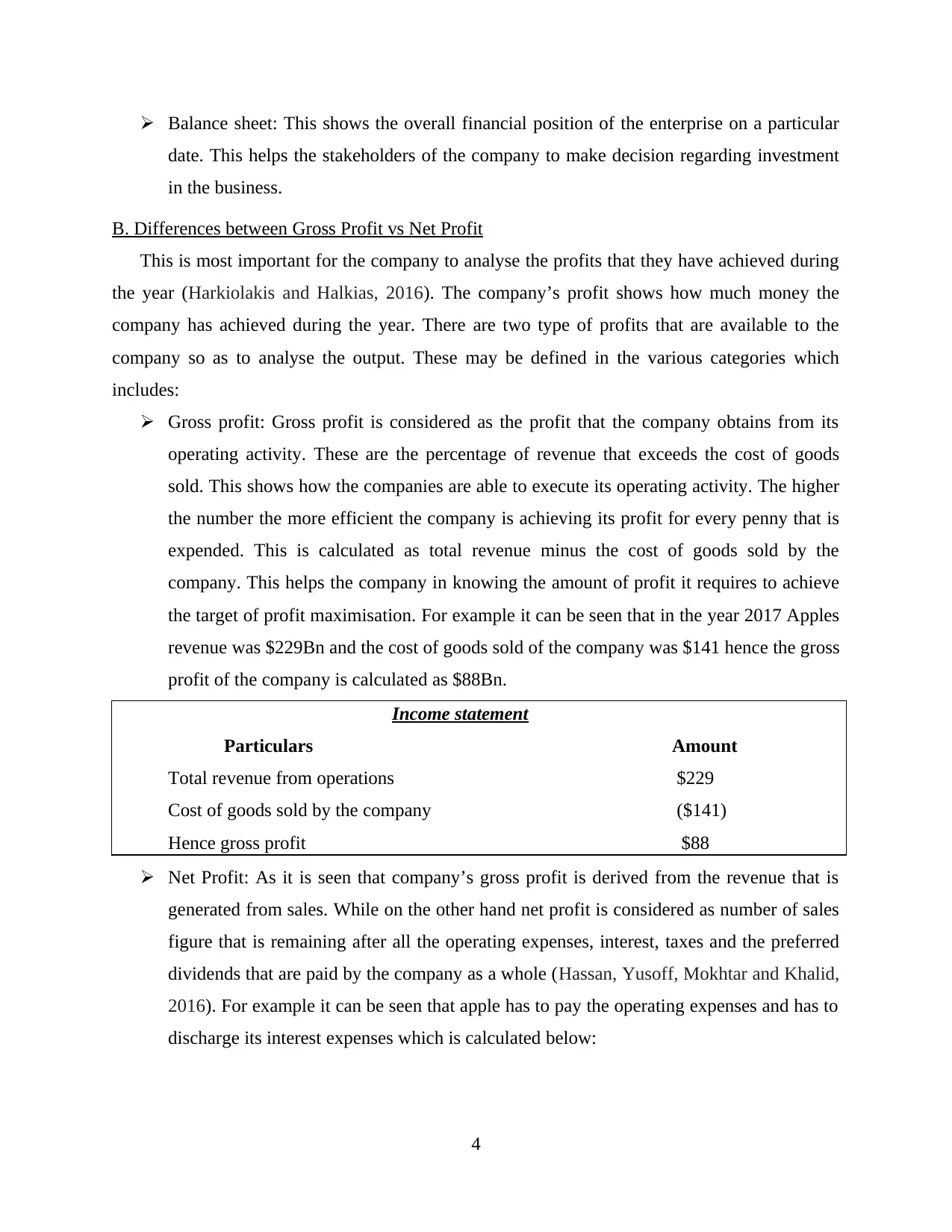
Balance sheet: This shows the overall financial position of the enterprise on a particular
date. This helps the stakeholders of the company to make decision regarding investment
in the business.
B. Differences between Gross Profit vs Net Profit
This is most important for the company to analyse the profits that they have achieved during
the year (Harkiolakis and Halkias, 2016). The company’s profit shows how much money the
company has achieved during the year. There are two type of profits that are available to the
company so as to analyse the output. These may be defined in the various categories which
includes:
Gross profit: Gross profit is considered as the profit that the company obtains from its
operating activity. These are the percentage of revenue that exceeds the cost of goods
sold. This shows how the companies are able to execute its operating activity. The higher
the number the more efficient the company is achieving its profit for every penny that is
expended. This is calculated as total revenue minus the cost of goods sold by the
company. This helps the company in knowing the amount of profit it requires to achieve
the target of profit maximisation. For example it can be seen that in the year 2017 Apples
revenue was $229Bn and the cost of goods sold of the company was $141 hence the gross
profit of the company is calculated as $88Bn.
Income statement
Particulars Amount
Total revenue from operations $229
Cost of goods sold by the company ($141)
Hence gross profit $88
Net Profit: As it is seen that company’s gross profit is derived from the revenue that is
generated from sales. While on the other hand net profit is considered as number of sales
figure that is remaining after all the operating expenses, interest, taxes and the preferred
dividends that are paid by the company as a whole (Hassan, Yusoff, Mokhtar and Khalid,
2016). For example it can be seen that apple has to pay the operating expenses and has to
discharge its interest expenses which is calculated below:
4
date. This helps the stakeholders of the company to make decision regarding investment
in the business.
B. Differences between Gross Profit vs Net Profit
This is most important for the company to analyse the profits that they have achieved during
the year (Harkiolakis and Halkias, 2016). The company’s profit shows how much money the
company has achieved during the year. There are two type of profits that are available to the
company so as to analyse the output. These may be defined in the various categories which
includes:
Gross profit: Gross profit is considered as the profit that the company obtains from its
operating activity. These are the percentage of revenue that exceeds the cost of goods
sold. This shows how the companies are able to execute its operating activity. The higher
the number the more efficient the company is achieving its profit for every penny that is
expended. This is calculated as total revenue minus the cost of goods sold by the
company. This helps the company in knowing the amount of profit it requires to achieve
the target of profit maximisation. For example it can be seen that in the year 2017 Apples
revenue was $229Bn and the cost of goods sold of the company was $141 hence the gross
profit of the company is calculated as $88Bn.
Income statement
Particulars Amount
Total revenue from operations $229
Cost of goods sold by the company ($141)
Hence gross profit $88
Net Profit: As it is seen that company’s gross profit is derived from the revenue that is
generated from sales. While on the other hand net profit is considered as number of sales
figure that is remaining after all the operating expenses, interest, taxes and the preferred
dividends that are paid by the company as a whole (Hassan, Yusoff, Mokhtar and Khalid,
2016). For example it can be seen that apple has to pay the operating expenses and has to
discharge its interest expenses which is calculated below:
4
Paraphrase This Document
Need a fresh take? Get an instant paraphrase of this document with our AI Paraphraser

Income statement
Particulars Amount
Total revenue from operations $229
Cost of goods sold by the company ($141)
Gross profit $88
Operating Expenses ($20)
Earnings before interest and tax $68
Interest Expenses ($10)
Net income for the year $58
C. Difference between non-current assets and current assets and non-current liabilities and
current liabilities.
The company has different assets which are categorised as per the liquidity period and as per
the term of its use (Hirschmeier and Yui, 2018). These can be used by the company for the long
term or for the short term period. It is seen that the company depends on these assets and
liabilities for its operations. There are various assets and liabilities which are divided into
different conditions these are categorised as below:
Non-current assets: It is termed as the asset which are used by the company for the long
period of time. Non- current assets are the company’s long term investments and the full
value of these type assets will not be realized by company within one accounting year.
Assets of Company devoted cost of asset over the number of years for the years the asset
will be in use. Some of the example of short term assets includes, land, buildings, plant
and machinery, equipment, furniture etc.
Current Asset: This is the asset that can be converted into the cash or its equivalent form
within the first financial year. These are used by the company to pay off their debts and
are considered as the liquid asset of the company (Reid, 2018). This helps in fulfilling the
routine requirements of cash payment by the company. Various example of the current
assets includes, cash, inventories, marketable securities, accounts receivable, prepaid
expenses and many more.
Non-current liabilities: These are the long term liabilities that are incorporated in the
company for a long period of time. These are used by the companies for the purpose of
5
Particulars Amount
Total revenue from operations $229
Cost of goods sold by the company ($141)
Gross profit $88
Operating Expenses ($20)
Earnings before interest and tax $68
Interest Expenses ($10)
Net income for the year $58
C. Difference between non-current assets and current assets and non-current liabilities and
current liabilities.
The company has different assets which are categorised as per the liquidity period and as per
the term of its use (Hirschmeier and Yui, 2018). These can be used by the company for the long
term or for the short term period. It is seen that the company depends on these assets and
liabilities for its operations. There are various assets and liabilities which are divided into
different conditions these are categorised as below:
Non-current assets: It is termed as the asset which are used by the company for the long
period of time. Non- current assets are the company’s long term investments and the full
value of these type assets will not be realized by company within one accounting year.
Assets of Company devoted cost of asset over the number of years for the years the asset
will be in use. Some of the example of short term assets includes, land, buildings, plant
and machinery, equipment, furniture etc.
Current Asset: This is the asset that can be converted into the cash or its equivalent form
within the first financial year. These are used by the company to pay off their debts and
are considered as the liquid asset of the company (Reid, 2018). This helps in fulfilling the
routine requirements of cash payment by the company. Various example of the current
assets includes, cash, inventories, marketable securities, accounts receivable, prepaid
expenses and many more.
Non-current liabilities: These are the long term liabilities that are incorporated in the
company for a long period of time. These are used by the companies for the purpose of
5
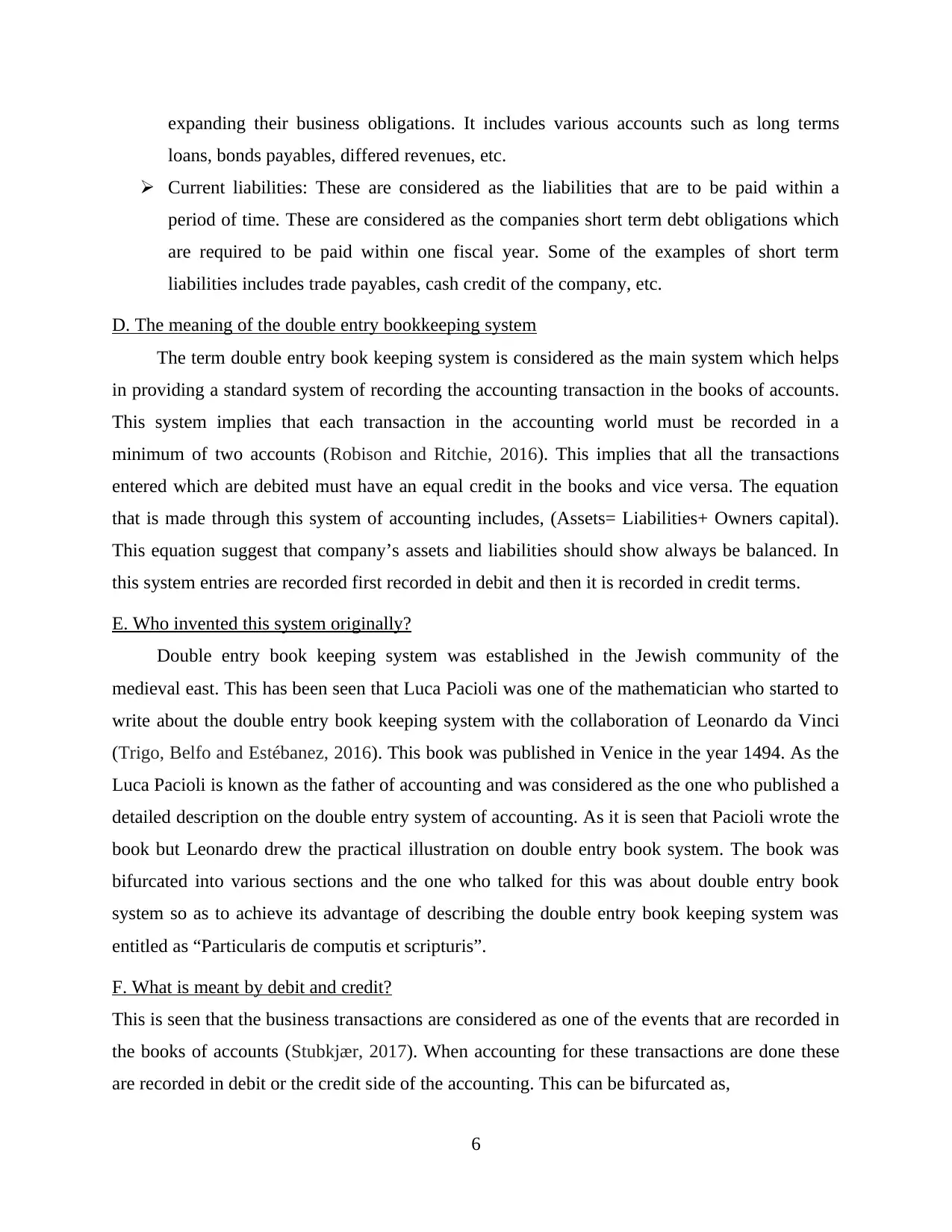
expanding their business obligations. It includes various accounts such as long terms
loans, bonds payables, differed revenues, etc.
Current liabilities: These are considered as the liabilities that are to be paid within a
period of time. These are considered as the companies short term debt obligations which
are required to be paid within one fiscal year. Some of the examples of short term
liabilities includes trade payables, cash credit of the company, etc.
D. The meaning of the double entry bookkeeping system
The term double entry book keeping system is considered as the main system which helps
in providing a standard system of recording the accounting transaction in the books of accounts.
This system implies that each transaction in the accounting world must be recorded in a
minimum of two accounts (Robison and Ritchie, 2016). This implies that all the transactions
entered which are debited must have an equal credit in the books and vice versa. The equation
that is made through this system of accounting includes, (Assets= Liabilities+ Owners capital).
This equation suggest that company’s assets and liabilities should show always be balanced. In
this system entries are recorded first recorded in debit and then it is recorded in credit terms.
E. Who invented this system originally?
Double entry book keeping system was established in the Jewish community of the
medieval east. This has been seen that Luca Pacioli was one of the mathematician who started to
write about the double entry book keeping system with the collaboration of Leonardo da Vinci
(Trigo, Belfo and Estébanez, 2016). This book was published in Venice in the year 1494. As the
Luca Pacioli is known as the father of accounting and was considered as the one who published a
detailed description on the double entry system of accounting. As it is seen that Pacioli wrote the
book but Leonardo drew the practical illustration on double entry book system. The book was
bifurcated into various sections and the one who talked for this was about double entry book
system so as to achieve its advantage of describing the double entry book keeping system was
entitled as “Particularis de computis et scripturis”.
F. What is meant by debit and credit?
This is seen that the business transactions are considered as one of the events that are recorded in
the books of accounts (Stubkjær, 2017). When accounting for these transactions are done these
are recorded in debit or the credit side of the accounting. This can be bifurcated as,
6
loans, bonds payables, differed revenues, etc.
Current liabilities: These are considered as the liabilities that are to be paid within a
period of time. These are considered as the companies short term debt obligations which
are required to be paid within one fiscal year. Some of the examples of short term
liabilities includes trade payables, cash credit of the company, etc.
D. The meaning of the double entry bookkeeping system
The term double entry book keeping system is considered as the main system which helps
in providing a standard system of recording the accounting transaction in the books of accounts.
This system implies that each transaction in the accounting world must be recorded in a
minimum of two accounts (Robison and Ritchie, 2016). This implies that all the transactions
entered which are debited must have an equal credit in the books and vice versa. The equation
that is made through this system of accounting includes, (Assets= Liabilities+ Owners capital).
This equation suggest that company’s assets and liabilities should show always be balanced. In
this system entries are recorded first recorded in debit and then it is recorded in credit terms.
E. Who invented this system originally?
Double entry book keeping system was established in the Jewish community of the
medieval east. This has been seen that Luca Pacioli was one of the mathematician who started to
write about the double entry book keeping system with the collaboration of Leonardo da Vinci
(Trigo, Belfo and Estébanez, 2016). This book was published in Venice in the year 1494. As the
Luca Pacioli is known as the father of accounting and was considered as the one who published a
detailed description on the double entry system of accounting. As it is seen that Pacioli wrote the
book but Leonardo drew the practical illustration on double entry book system. The book was
bifurcated into various sections and the one who talked for this was about double entry book
system so as to achieve its advantage of describing the double entry book keeping system was
entitled as “Particularis de computis et scripturis”.
F. What is meant by debit and credit?
This is seen that the business transactions are considered as one of the events that are recorded in
the books of accounts (Stubkjær, 2017). When accounting for these transactions are done these
are recorded in debit or the credit side of the accounting. This can be bifurcated as,
6
⊘ This is a preview!⊘
Do you want full access?
Subscribe today to unlock all pages.

Trusted by 1+ million students worldwide
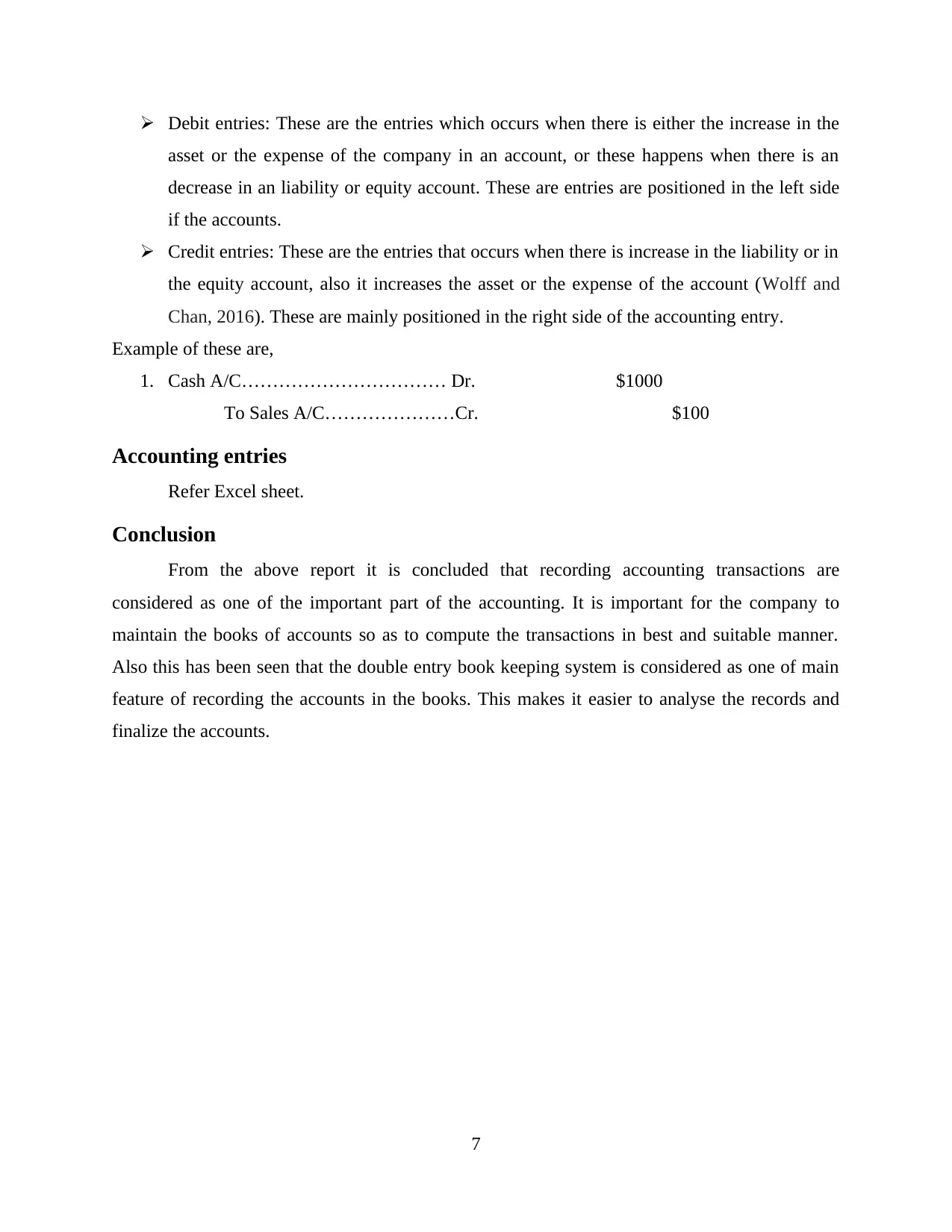
Debit entries: These are the entries which occurs when there is either the increase in the
asset or the expense of the company in an account, or these happens when there is an
decrease in an liability or equity account. These are entries are positioned in the left side
if the accounts.
Credit entries: These are the entries that occurs when there is increase in the liability or in
the equity account, also it increases the asset or the expense of the account (Wolff and
Chan, 2016). These are mainly positioned in the right side of the accounting entry.
Example of these are,
1. Cash A/C…………………………… Dr. $1000
To Sales A/C…………………Cr. $100
Accounting entries
Refer Excel sheet.
Conclusion
From the above report it is concluded that recording accounting transactions are
considered as one of the important part of the accounting. It is important for the company to
maintain the books of accounts so as to compute the transactions in best and suitable manner.
Also this has been seen that the double entry book keeping system is considered as one of main
feature of recording the accounts in the books. This makes it easier to analyse the records and
finalize the accounts.
7
asset or the expense of the company in an account, or these happens when there is an
decrease in an liability or equity account. These are entries are positioned in the left side
if the accounts.
Credit entries: These are the entries that occurs when there is increase in the liability or in
the equity account, also it increases the asset or the expense of the account (Wolff and
Chan, 2016). These are mainly positioned in the right side of the accounting entry.
Example of these are,
1. Cash A/C…………………………… Dr. $1000
To Sales A/C…………………Cr. $100
Accounting entries
Refer Excel sheet.
Conclusion
From the above report it is concluded that recording accounting transactions are
considered as one of the important part of the accounting. It is important for the company to
maintain the books of accounts so as to compute the transactions in best and suitable manner.
Also this has been seen that the double entry book keeping system is considered as one of main
feature of recording the accounts in the books. This makes it easier to analyse the records and
finalize the accounts.
7
Paraphrase This Document
Need a fresh take? Get an instant paraphrase of this document with our AI Paraphraser
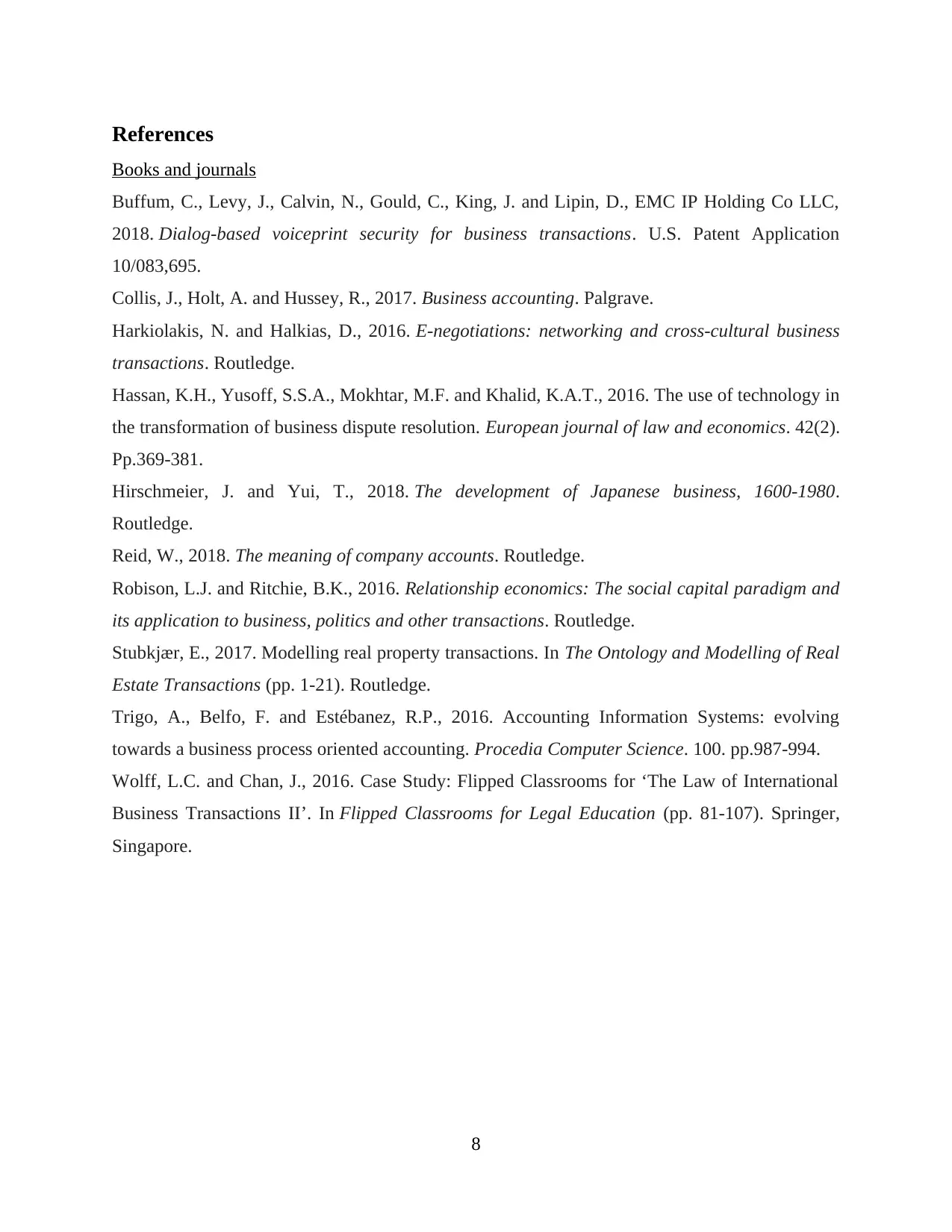
References
Books and journals
Buffum, C., Levy, J., Calvin, N., Gould, C., King, J. and Lipin, D., EMC IP Holding Co LLC,
2018. Dialog-based voiceprint security for business transactions. U.S. Patent Application
10/083,695.
Collis, J., Holt, A. and Hussey, R., 2017. Business accounting. Palgrave.
Harkiolakis, N. and Halkias, D., 2016. E-negotiations: networking and cross-cultural business
transactions. Routledge.
Hassan, K.H., Yusoff, S.S.A., Mokhtar, M.F. and Khalid, K.A.T., 2016. The use of technology in
the transformation of business dispute resolution. European journal of law and economics. 42(2).
Pp.369-381.
Hirschmeier, J. and Yui, T., 2018. The development of Japanese business, 1600-1980.
Routledge.
Reid, W., 2018. The meaning of company accounts. Routledge.
Robison, L.J. and Ritchie, B.K., 2016. Relationship economics: The social capital paradigm and
its application to business, politics and other transactions. Routledge.
Stubkjær, E., 2017. Modelling real property transactions. In The Ontology and Modelling of Real
Estate Transactions (pp. 1-21). Routledge.
Trigo, A., Belfo, F. and Estébanez, R.P., 2016. Accounting Information Systems: evolving
towards a business process oriented accounting. Procedia Computer Science. 100. pp.987-994.
Wolff, L.C. and Chan, J., 2016. Case Study: Flipped Classrooms for ‘The Law of International
Business Transactions II’. In Flipped Classrooms for Legal Education (pp. 81-107). Springer,
Singapore.
8
Books and journals
Buffum, C., Levy, J., Calvin, N., Gould, C., King, J. and Lipin, D., EMC IP Holding Co LLC,
2018. Dialog-based voiceprint security for business transactions. U.S. Patent Application
10/083,695.
Collis, J., Holt, A. and Hussey, R., 2017. Business accounting. Palgrave.
Harkiolakis, N. and Halkias, D., 2016. E-negotiations: networking and cross-cultural business
transactions. Routledge.
Hassan, K.H., Yusoff, S.S.A., Mokhtar, M.F. and Khalid, K.A.T., 2016. The use of technology in
the transformation of business dispute resolution. European journal of law and economics. 42(2).
Pp.369-381.
Hirschmeier, J. and Yui, T., 2018. The development of Japanese business, 1600-1980.
Routledge.
Reid, W., 2018. The meaning of company accounts. Routledge.
Robison, L.J. and Ritchie, B.K., 2016. Relationship economics: The social capital paradigm and
its application to business, politics and other transactions. Routledge.
Stubkjær, E., 2017. Modelling real property transactions. In The Ontology and Modelling of Real
Estate Transactions (pp. 1-21). Routledge.
Trigo, A., Belfo, F. and Estébanez, R.P., 2016. Accounting Information Systems: evolving
towards a business process oriented accounting. Procedia Computer Science. 100. pp.987-994.
Wolff, L.C. and Chan, J., 2016. Case Study: Flipped Classrooms for ‘The Law of International
Business Transactions II’. In Flipped Classrooms for Legal Education (pp. 81-107). Springer,
Singapore.
8
1 out of 8
Related Documents
Your All-in-One AI-Powered Toolkit for Academic Success.
+13062052269
info@desklib.com
Available 24*7 on WhatsApp / Email
![[object Object]](/_next/static/media/star-bottom.7253800d.svg)
Unlock your academic potential
Copyright © 2020–2025 A2Z Services. All Rights Reserved. Developed and managed by ZUCOL.





